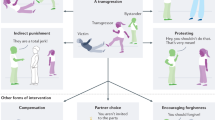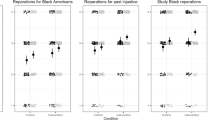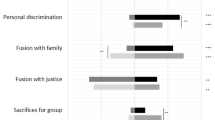Abstract
Researchers argue that third parties help sustain human cooperation, yet how they contribute remains unclear, especially in small-scale, politically decentralized societies. Studying justice among Mentawai horticulturalists in Indonesia, we examined evidence for punishment and mediation by third parties. Across a sample of 444 transgressions, we find no evidence of direct third-party punishment. Most victims and aggrieved parties demanded payment, and if a transgressor faced punishment, this was never imposed by third parties. We find little evidence of indirect sanctions by third parties. Nearly 20% of transgressions were followed by no payment, and as predicted by dyadic models of sanctions, payments were less likely when transgressions were among related individuals. Approximately 75% of non-governmental mediators called were third parties, especially shamans and elders, and mediators were called more as cooperation was threatened. Our findings suggest that, among the Mentawai, institutionalized penalties function more to restore dyadic cooperation than to enforce norms.
This is a preview of subscription content, access via your institution
Access options
Access Nature and 54 other Nature Portfolio journals
Get Nature+, our best-value online-access subscription
$29.99 / 30 days
cancel any time
Subscribe to this journal
Receive 12 digital issues and online access to articles
$119.00 per year
only $9.92 per issue
Buy this article
- Purchase on Springer Link
- Instant access to full article PDF
Prices may be subject to local taxes which are calculated during checkout





Similar content being viewed by others
Data availability
All cleaned, anonymized data are available at the OSF project page at https://osf.io/r5jv6/.
Code availability
All code used in analyses is available at the OSF project page at https://osf.io/r5jv6/.
References
Durkheim, E. On the division of labor in society. Zeitschrift für Sozialforschung https://doi.org/10.5840/zfs19343310 (1934).
Boyd, R., Gintis, H., Bowles, S. & Richerson, P. J. The evolution of altruistic punishment. Proc. Natl Acad. Sci. USA 100, 3531–3535 (2003).
Boyd, R., Gintis, H. & Bowles, S. Coordinated punishment of defectors sustains cooperation and can proliferate when rare. Science 328, 617–620 (2010).
Boyd, R. & Richerson, P. J. Punishment allows the evolution of cooperation (or anything else) in sizable groups. Ethol. Sociobiol. 13, 171–195 (1992).
Marshall, J., Yudkin, D. A. & Crockett, M. J. Children punish third parties to satisfy both consequentialist and retributive motives. Nat. Hum. Behav. 5, 361–368 (2021).
Hamlin, J. K., Wynn, K., Bloom, P. & Mahajan, N. How infants and toddlers react to antisocial others. Proc. Natl Acad. Sci. USA 108, 19931–19936 (2011).
Heyman, G. D., Chiu Loke, I. & Lee, K. Children spontaneously police adults’ transgressions. J. Exp. Child Psychol. 150, 155–164 (2016).
House, B. R. et al. Social norms and cultural diversity in the development of third-party punishment. Proc. R. Soc. B Biol. Sci. 287, 20192794 (2020).
Balafoutas, L., Nikiforakis, N. & Rockenbach, B. Direct and indirect punishment among strangers in the field. Proc. Natl Acad. Sci. USA 111, 15924–15927 (2014).
Mathew, S. How the second-order free rider problem is solved in a small-scale society. Am. Econ. Rev. 107, 578–581 (2017).
Mathew, S. & Boyd, R. Punishment sustains large-scale cooperation in prestate warfare. Proc. Natl Acad. Sci. USA 108, 11375–11380 (2011).
Leeson, P. T. An-arrgh‐chy: the law and economics of pirate organization. J. Polit. Econ. 115, 1049–1094 (2007).
McDowell, A. G. From commons to claims: property rights in the California gold rush. Yale J. Law Humanit. http://hdl.handle.net/20.500.13051/7318 (2002).
Hadfield, G. K. & Weingast, B. R. Law without the state: legal attributes and the coordination of decentralized collective punishment. J. Law Court. https://doi.org/10.1086/668604 (2013).
Boehm, C. Moral Origins: The Evolution of Virtue, Altruism, and Shame (Basic Books, 2012).
Wrangham, R. W. The Goodness Paradox: The Strange Relationship between Peace and Violence in Human Evolution (Vintage, 2019).
Wrangham, R. W. Targeted conspiratorial killing, human self-domestication and the evolution of groupishness. Evol. Hum. Sci. 3, e26 (2021).
Boyd, R. A Different Kind of Animal: How Culture Transformed our Species (Princeton Univ. Press, 2018).
Henrich, J. et al. Markets, religion, community size, and the evolution of fairness and punishment. Science 327, 1480–1484 (2010).
Baumard, N. Has punishment played a role in the evolution of cooperation? A critical review. Mind Soc. https://doi.org/10.1007/s11299-010-0079-9 (2010).
Black, D. On the origin of morality. J. Conscious. Stud. 7, 107–119 (2000).
Marlowe, F. W. et al. More ‘altruistic’ punishment in larger societies. Proc. Biol. Sci. 275, 587–590 (2008).
Berndt, R. M. & Berndt, C. H. The World of the First Australians: Aboriginal Traditional Life: Past and Present (Aboriginal Studies Press, 1988).
Berndt, R. M. in Aboriginal Man in Australia: Essays in Honour of Emeritus Professor A. P. Elkin (eds Berndt, R. M. & Berndt, C. H.) 167–206 (Angus and Robertson, 1965).
Raihani, N. J. & Bshary, R. Punishment: One tool, many uses. Evol. Hum. Sci. 2, E4 (2019).
Hoebel, E. A. The Law of Primitive Man: A Study in Comparative Legal Dynamics (Harvard Univ. Press, 1954).
Henrich, J. & Muthukrishna, M. The origins and psychology of human cooperation. Annu. Rev. Psychol. 72, 207–240 (2021).
Boyd, R. & Mathew, S. Arbitration supports reciprocity when there are frequent perception errors. Nat. Hum. Behav. 5, 596–603 (2021).
Smith, J. E. et al. Leadership in mammalian societies: emergence, distribution, power, and payoff. Trends Ecol. Evol. 31, 54–66 (2016).
Garfield, Z. H., Syme, K. L. & Hagen, E. H. Universal and variable leadership dimensions across human societies. Evol. Hum. Behav. 41, 397–414 (2020).
Garfield, Z. H. Correlates of conflict resolution across cultures. Evol. Hum. Sci. 3, e45 (2021).
Glowacki, L. & von Rueden, C. Leadership solves collective action problems in small-scale societies. Philos. Trans. R. Soc. B. 370, 20150010 (2015).
Wiessner, P. Norm enforcement among the Ju/’hoansi Bushmen. Hum. Nat. 16, 115–145 (2005).
Wiessner, P. The role of third parties in norm enforcement in customary courts among the Enga of Papua. Proc. Natl Acad. Sci. USA 117, 32320–32328 (2020).
Tulius, J. Family Stories: Oral Tradition, Memories of the Past, and Contemporary Conflicts Over Land In Mentawai – Indonesia. (Leiden Univ., 2012).
2011-2012 Community Research Report (Suku Mentawai: Indigenous Education Foundation, 2012); https://iefprograms.org/wp-content/documents/suku-mentawai/SukuMentawai_CRR.pdf
Schefold, R. Lia: Das grosse Ritual auf den Mentawai-Inseln (Indonesien) (Dietrich Reimer Verlag, 1988).
Delfi, M. Local belief system, tatouage, tradition and adaptation in Mentawai. In Proc. 3rd International Indonesian Forum for Asian Studies 900–911 (2017).
Hammons, C. S. Sakaliou: Reciprocity, Mimesis, and the Cultural Economy Of Tradition In Siberut, Mentawai Islands, Indonesia (Univ. Southern California, 2010).
Singh, M. & Henrich, J. Why do religious leaders observe costly prohibitions? Examining taboos on Mentawai shamans. Evol. Hum. Sci. 2, e32 (2020).
Singh, M., Kaptchuk, T. J. & Henrich, J. Small gods, rituals, and cooperation: the Mentawai water spirit Sikameinan. Evol. Hum. Behav. 42, 61–72 (2021).
Schefold, R. Ambivalent blessings: head-hunting on Siberut (Mentawai) in a comparative Southeast Asian perspective. Anthropos 102, 479–494 (2007).
Loeb, E. M. Mentawei social organization. Am. Anthropol. 3, 408–433 (1928).
Tulius, J. in Heritage and Rights of Indigenous Peoples (Patrimonio y derechos de los pueblos indigenas) (eds Castillo, M. M. & Strecker, A.) 109–136 (Leiden Univ. Press, 2017).
Delfi, M. Islam and Arat Sabulungan in Mentawai. Al-Jami’ah J. Islam. Stud. https://doi.org/10.14421/ajis.2013.512.475-499 (2013).
Schefold, R. The culinary code in the puliaijat ritual of the Mentawaians. Bijdr. tot Taal-, Land-en. Volkenkd. 138, 64–97 (1982).
Caissutti, T. La Cultura Mentawaiana (Asian Study Centre, 2015).
Darmanto, D. Good to Produce, Good to Share: Food, Hunger, and Social Values in a Contemporary Mentawaian Community, Indonesia (Leiden Univ., 2020).
Persoon, G. A. in The Leiden Tradition in Structural Anthropology: Essays in Honor of P. E. de Josselin de Jong (eds de Ridder, R. & Karremans, J. A. J.) 140–160 (Brill, 1987).
Persoon, G. A. Vluchten of Veranderen: Processen van Verandering en Ontwikkeling bij Tribale Groepen in Indonesië. PhD thesis, Leiden Univ. (1994).
Panchanathan, K. & Boyd, R. Indirect reciprocity can stabilize cooperation without the second-order free rider problem. Nature 432, 499–502 (2004).
Delton, A. W. & Krasnow, M. M. The psychology of deterrence explains why group membership matters for third-party punishment. Evol. Hum. Behav. 38, 734–743 (2017).
McCullough, M. E., Kurzban, R. & Tabak, B. A. Cognitive systems for revenge and forgiveness. Behav. Brain Sci. https://doi.org/10.1017/S0140525X11002160 (2013).
Singh, M. The cultural evolution of shamanism. Behav. Brain Sci. 41, e66 (2018).
Winkelman, M. J. Shamans and other ‘magico-religious’ healers: a cross-cultural study of their origins, nature, and social transformations. Ethos 18, 308–352 (1990).
Fehr, E. & Fischbacher, U. Third-party punishment and social norms. Evol. Hum. Behav. 25, 63–87 (2004).
Petersen, M. B., Sell, A., Tooby, J. & Cosmides, L. To punish or repair? Evolutionary psychology and lay intuitions about modern criminal justice. Evol. Hum. Behav. 33, 682–695 (2012).
Garfield, Z. H. et al. The content and structure of reputation domains across human societies: a view from the evolutionary social sciences. Philos. Trans. R. Soc. B Biol. Sci. 376, 20200296 (2021).
Lightner, A. D., Heckelsmiller, C. & Hagen, E. H. Ethnoscientific expertise and knowledge specialisation in 55 traditional cultures. Evol. Hum. Sci. https://doi.org/10.1017/ehs.2021.31 (2021).
Sahlins, M. D. Poor man, rich man, big-man, chief: political types in Melanesia and Polynesia. Comp. Stud. Soc. Hist. 5, 285–303 (1963).
Singh, M. & Glowacki, L. Human social organization during the Late Pleistocene: beyond the nomadic-egalitarian model. Preprint at https://ecoevorxiv.org/vusye/ (2021).
Wiessner, P. in Überlebensstrategien in Afrika (eds Bollig, M. & Klees, F.) 101–124 (Heinrich-Barth Institut, 1994).
Garfield, Z. H. & Hagen, E. H. Investigating evolutionary models of leadership among recently settled Ethiopian hunter-gatherers. Leadersh. Q. 31, 101290 (2020).
Ghosh, J., Li, Y. & Mitra, R. On the use of Cauchy prior distributions. Bayesian Anal. 13, 359–383 (2018).
Gelman, A. & Tuerlinckx, F. Type S error rates classical and Bayesian single and multiple comparison procedures. Comput. Stat. 15, 373–390 (2000).
Acknowledgements
L. Fitouchi, L. Glowacki, J. Henrich, H. Larreguy, S. Mathew, C. Molho, C. von Rueden and members of IAST’s Social Evolution Team shared valuable comments on earlier versions of this manuscript. M. Delfi, B. Sakaliou and G. Sakaliou assisted with fieldwork. R. Henry and J. Tulius assisted with clarifying Mentawai terminology. Data collection by M.S. was funded by a National Science Graduate Research Fellowship, a Sheldon Traveling Fellowship from the Harvard Committee on General Scholarships and a grant from the Mind, Brain and Behavior Initiative at Harvard University. Both authors acknowledge IAST funding from ANR under grant no. ANR-17-EURE-0010 (Investissements d’Avenir programme).
Author information
Authors and Affiliations
Contributions
M.S. collected data as part of ongoing field research. M.S. and Z.H.G. conceived the study, designed and conducted analyses, and wrote the manuscript.
Corresponding author
Ethics declarations
Competing interests
The authors declare no competing interests.
Peer review
Peer review information
Nature Human Behaviour thanks Lee Cronk, Gerard Persoon, Jeffrey Winking and the other, anonymous, reviewer(s) for their contribution to the peer review of this work. Peer reviewer reports are available.
Additional information
Publisher’s note Springer Nature remains neutral with regard to jurisdictional claims in published maps and institutional affiliations.
Extended data
Extended Data Fig. 1 Predictors of a case being mediated.
The figure shows the estimated log odds (x-axis) for predicting whether a mediator was called (model 3) (n = 199 cases). ‘Same clan status’ is a binary variable capturing whether disputants are in the same clan (1) or different clans (0). Points and error bars are posterior means with 95% credible intervals. The shaded areas and distributions respectively represent 50%, 80%, and 95% of the posterior distributions.
Extended Data Fig. 2 Comparing governmental and non-governmental mediation.
The figure shows the estimated severities of transgressions (x-axis) for which local mediators were called and for which governmental officials were called to mediate (n = 208 cases). Points and error bars are posterior means with 95% credible intervals. The shaded areas and distributions respectively represent 50%, 80%, and 95% of the posterior distributions.
Supplementary information
Supplementary Information
Supplementary Figs. 1 and 2 and Tables 1–10.
Rights and permissions
About this article
Cite this article
Singh, M., Garfield, Z.H. Evidence for third-party mediation but not punishment in Mentawai justice. Nat Hum Behav 6, 930–940 (2022). https://doi.org/10.1038/s41562-022-01341-7
Received:
Accepted:
Published:
Issue Date:
DOI: https://doi.org/10.1038/s41562-022-01341-7
This article is cited by
-
The problem of opportunity
Biology & Philosophy (2023)



